Research Article
Volume 1 Issue 4 - 2017
Effect of Blending Tamr and Honey with Goat’s Milk on Chemical Composition, Starter Activity and Rheological Characteristics
1Department of Dairying, Faculty of Agriculture, Damietta University, Damietta, Egypt
2Dairy Technology Department, Animal Production Research Institute, Agricultural Research Center, Dokki, Giza, Egypt
3Independent Scholar, Damietta, Egypt
2Dairy Technology Department, Animal Production Research Institute, Agricultural Research Center, Dokki, Giza, Egypt
3Independent Scholar, Damietta, Egypt
*Corresponding Author: Magdy Mohamed Ismail, Dairy Technology Department, Animal Production Research Institute, Agricultural Research Center, Dokki, Giza, Egypt.
Received: March 20, 2017; Published: August 11, 2017
Abstract
Chemical composition, activity of ABT culture and some rheological attributes of goat’s milk fortified with various concentrations of Tamr and honey were investigated. Mixing Tamr and honey with goat’s milk increased titratable acidity, redox potential, total solids and total protein contents but fat concentrations slightly lowered. The developments of acidity levels during fermentation as indictor for starter activity were higher in goat’s milk, Tamr and honey mixtures as compared with control (goat’s milk only). Goat’s milk fortified with Tamr and honey had the highest values of curd tension and water holding capacity and the lowest levels of syneresis. Addition of Tamr (10 or 15%) and honey (1 or 2%) highly improved the flavour of goat’s milk. Mixtures of goat’s milk, Tamr and honey can be used as sweetened dairy drinks or in preparation of sweetened fermented dairy products.
Keywords: Goat’s milk; ABT culture Tamr Honey
Introduction
The particular interest in goat’s milk is prompted by its indisputable dietetic properties. By chemical composition, goat’s milk is similar to cow’s milk, but the amounts of ingredients differ. The former has higher contents of dry matter, total protein and casein, milk fat and mineral substances, which determines its higher nutritive value [1]. Goat’s milk fat contains more vitamin A than cow’s milk. The fatty acid composition of goat’s milk is also different, being richer in volatile fatty acids (caproic, caprylic, and capric) that are responsible for the specific taste and odour of the respective dairy products. The higher content of medium-chain fatty acids accounts also for the more prolonged bacteriostatic stage.
Since 6000 years ago and till nowadays, dates (Phoenix dactylifera L) continue to play an essential role in the diet of people of the Middle East area. They are commonly consumed as fresh (Khalal and Rutab) or as dry (Tamr) fruits [2]. The fruits are also used in food technology to produce a range of commercial products [3].
On the other hand, the use of natural honey as food and medicine by mankind has been in existence from time immemorial. Natural honey is accepted by all generations, traditions and civilizations, both ancient and modern. Also, it is recommended in all religious books. Honey is enriched in oligosaccharides such as sucrose, maltose, trehalose, turanose, panose,1-kestose, 6-kestose and palatinose. Honey contains a number of mineral elements such as zinc, selenium, copper, calcium, potassium, chromium, manganese and so on. Some of these minerals such as chromium are recognized for their role in the reduction of elevated blood glucose, maintenance of normal glucose tolerance and insulin secretion from the pancreatic β-cells [4]. Therefore, the objective of this study was to investigate the impact of addition Tamr and honey on chemical composition, starter activity and rheological properties of goat’s milk.
Materials and Methods
Materials
Fresh goat’s milk was obtained from El-Serw Animal Production Research Station, Animal Production Research Institute, Agricultural Research Center, Egypt. The chemical composition of milk was. ABT culture (ABT-5) with mixed strains of S. thermophilus (as sole fermenting organism) and LA+ B. bifidum (as probiotic organisms) (Chr. Hansen’s Lab A/S Copenhagen, Denmark) were used. The starter culture was in freeze-dried direct-to-vat set form. After procurement, the starter cultures were stored at –18°C in the absence of atmospheric air. Saidy variety of date (P. dactylifera L) at the Tamr stage of maturity and honey were obtained from local market in Damiette Governorate, Egypt.
Fresh goat’s milk was obtained from El-Serw Animal Production Research Station, Animal Production Research Institute, Agricultural Research Center, Egypt. The chemical composition of milk was. ABT culture (ABT-5) with mixed strains of S. thermophilus (as sole fermenting organism) and LA+ B. bifidum (as probiotic organisms) (Chr. Hansen’s Lab A/S Copenhagen, Denmark) were used. The starter culture was in freeze-dried direct-to-vat set form. After procurement, the starter cultures were stored at –18°C in the absence of atmospheric air. Saidy variety of date (P. dactylifera L) at the Tamr stage of maturity and honey were obtained from local market in Damiette Governorate, Egypt.
Methods
Preparation of Tamr
Tamr of good quality were carefully selected and washed with tap water after removing of the kernels. The flesh was cut into small pieces, soaked in hot water (90°C) for 3 min and directly soaked in previously heat treated milk.
Preparation of Tamr
Tamr of good quality were carefully selected and washed with tap water after removing of the kernels. The flesh was cut into small pieces, soaked in hot water (90°C) for 3 min and directly soaked in previously heat treated milk.
Preparation of Goat’s milk, Tamr and honey Mixtures
Tamr and honey were added to goat’s milk as follow:
Sample A: Goat’s milk (control)
Sample B: Goat’s milk + 5% Tamr
Sample C: Goat’s milk + 10% Tamr
Sample D: Goat’s milk + 15% Tamr
Sample E: Goat’s milk + 20% Tamr
Sample F: Goat’s milk + 25% Tamr
Sample G: Goat’s milk + 10% Tamr + 1% Honey
Sample H: Goat’s milk + 10% Tamr + 2% Honey
Sample I: Goat’s milk + 10% Tamr + 3% Honey
Sample J: Goat’s milk + 15% Tamr + 1% Honey
Sample K: Goat’s milk + 15% Tamr + 2% Honey
Sample L: Goat’s milk + 15% Tamr + 3% Honey
Tamr and honey were added to goat’s milk as follow:
Sample A: Goat’s milk (control)
Sample B: Goat’s milk + 5% Tamr
Sample C: Goat’s milk + 10% Tamr
Sample D: Goat’s milk + 15% Tamr
Sample E: Goat’s milk + 20% Tamr
Sample F: Goat’s milk + 25% Tamr
Sample G: Goat’s milk + 10% Tamr + 1% Honey
Sample H: Goat’s milk + 10% Tamr + 2% Honey
Sample I: Goat’s milk + 10% Tamr + 3% Honey
Sample J: Goat’s milk + 15% Tamr + 1% Honey
Sample K: Goat’s milk + 15% Tamr + 2% Honey
Sample L: Goat’s milk + 15% Tamr + 3% Honey
The mentioned percentages of Tamr were soaked in milk for 12 h at 5°C then the mixture was blended at 2000 rpm for 3 min and carefully filtered. All milk samples were reheated to 40°C and honey was added. For measurement of starter activity, different milk samples were inoculated with cultures (0.1 g/L of milk mix) and incubated at 40°C for 240 min. The changes of acidity (as lactic acid percentages), pH and Eh values of inoculated milk were determined at 30 min intervals till 240 min. For determination of curd tension and syneresis, milk samples were inoculated, incubated at 40°C for fully coagulation and stored at 4°C overnight.
Methods of Analysis
Chemical analysis
Total solids, fat and total nitrogen contents of milk samples were determined according to AOAC [5]. Titratable acidity in terms of % lactic acid was measured by titrating 10g of sample mixed with 10ml of boiling distilled water against 0.1 N NaOH using a 0.5% phenolphthalein indicator to an end point of faint pink color. pH of the sample was measured at 17 to 20°C using a pH meter (Corning pH/ion analyzer 350, Corning, NY) after calibration with standard buffers (pH 4.0 and 7.0). Redox potential was measured with a platinum electrode [model P14805-SC-DPAS-K8S/325; Ingold (now Mettler Toledo), Urdorf, Switzerland] connected to a pH meter (model H 18418; Hanna Instruments, Padova, Italy).
Total solids, fat and total nitrogen contents of milk samples were determined according to AOAC [5]. Titratable acidity in terms of % lactic acid was measured by titrating 10g of sample mixed with 10ml of boiling distilled water against 0.1 N NaOH using a 0.5% phenolphthalein indicator to an end point of faint pink color. pH of the sample was measured at 17 to 20°C using a pH meter (Corning pH/ion analyzer 350, Corning, NY) after calibration with standard buffers (pH 4.0 and 7.0). Redox potential was measured with a platinum electrode [model P14805-SC-DPAS-K8S/325; Ingold (now Mettler Toledo), Urdorf, Switzerland] connected to a pH meter (model H 18418; Hanna Instruments, Padova, Italy).
Rheological Analyses
The curd tension was determined using the method of Chandrasekhara., et al. [6] whereas the susceptibility to syneresis (STS) was measured as given by Kpodo., et al. [7]. For test of starter coagulation time during Rayeb milk making, milk was inculcated with starts and incubated at 40°C then coagulation was noticed at 30 min intervals. Water holding capacity (WHC) was measured according to Yousef., et al. [8].
The curd tension was determined using the method of Chandrasekhara., et al. [6] whereas the susceptibility to syneresis (STS) was measured as given by Kpodo., et al. [7]. For test of starter coagulation time during Rayeb milk making, milk was inculcated with starts and incubated at 40°C then coagulation was noticed at 30 min intervals. Water holding capacity (WHC) was measured according to Yousef., et al. [8].
Sensory properties judging
Samples of goat’s milk mixed with Tamr and honey were organoleptically scored by the staff of the Dairy Department, Faculty of Agricultural, and Damietta University. The score points were 50 for flavour, 35 for body and texture and 15 for colour and appearance, which give a total score of 100 points.
Samples of goat’s milk mixed with Tamr and honey were organoleptically scored by the staff of the Dairy Department, Faculty of Agricultural, and Damietta University. The score points were 50 for flavour, 35 for body and texture and 15 for colour and appearance, which give a total score of 100 points.
Results and Discussion
Physiochemical composition of goat’ milk, Tamr and honey mixtures
Titratable acidity, pH, redox potential (Eh), total solids, fat and total protein values of goat’s milk mixed with various Tamr and honey amounts were showed in Table 1. The chemical composition of goat’s milk was within the normal range. The values of above mentioned properties corresponded to the results reported by other research workers [9,10]. Mixing various concentrations of Tamr with goats milk markedly increased acidity and Eh while decreased pH values. With increasing of Tamr amounts added to goat’s milk, total solids (TS) and total protein contents raised but fat concentrations slightly lowered.
Titratable acidity, pH, redox potential (Eh), total solids, fat and total protein values of goat’s milk mixed with various Tamr and honey amounts were showed in Table 1. The chemical composition of goat’s milk was within the normal range. The values of above mentioned properties corresponded to the results reported by other research workers [9,10]. Mixing various concentrations of Tamr with goats milk markedly increased acidity and Eh while decreased pH values. With increasing of Tamr amounts added to goat’s milk, total solids (TS) and total protein contents raised but fat concentrations slightly lowered.
On the other hand, addition 1, 2 and 3% honey to goat’s milk fortified with 10 or 15%Tamr slightly increased titratable acidity and Eh while decreased pH values which could be attributed to fructooligosacchrides in honey [11]. Also, blending honey with goat’s milk and Tamr mixtures increased TS contents but fat and total protein values were not affected.
*mV: millivolts
*mV: millivolts
| Treatments | Acidity (%) | pH values | Eh (mV*) | TS (%) | Fat (%) | TP (%) |
| A | 0.16 | 6.65 | 28.7 | 13.12 | 4.1 | 3.52 |
| B | 0.18 | 6.58 | 33.8 | 16.41 | 4.1 | 3.61 |
| C | 0.19 | 6.54 | 35.3 | 19.22 | 4.0 | 3.70 |
| D | 0.20 | 6.52 | 37.5 | 20.94 | 4.0 | 3.95 |
| E | 0.23 | 6.48 | 41.7 | 24.11 | 3.9 | 4.07 |
| F | 0.27 | 6.44 | 45.8 | 26.87 | 3.8 | 4.15 |
| G | 0.19 | 6.53 | 35.5 | 20.14 | 4.0 | 3.73 |
| H | 0.20 | 6.51 | 37.6 | 21.35 | 4.0 | 3.68 |
| I | 0.20 | 6.51 | 37.5 | 22.16 | 3.9 | 3.66 |
| J | 0.20 | 6.52 | 37.6 | 21.87 | 4.0 | 3.91 |
| K | 0.21 | 6.50 | 39.11 | 22.90 | 4.0 | 3.94 |
| L | 0.21 | 6.50 | 39.14 | 23.74 | 3.8 | 3.92 |
Table 1: Prevalence of Clinical Symptoms among Diabetics.
*Multiple responses
*Multiple responses
Starter activity in goat’s milk fortified with Tamr and honey
As it is expected, a gradual increase of titratable acidity and redox potential values in all milk treatments were noticed during fermentation period (Figures 1-6). Values of pH had the opposite trend of acidity and redox potential. The changes in acidity, Eh and pH changes could be attributed to the number and/or metabolic activity of acid producing micro-organisms. As starter grows, they produce acid which causes an increase in acidity and Eh and a decrease in pH. These results are in agreement with those previously reported for fermented milk “Lebens” [12].
As it is expected, a gradual increase of titratable acidity and redox potential values in all milk treatments were noticed during fermentation period (Figures 1-6). Values of pH had the opposite trend of acidity and redox potential. The changes in acidity, Eh and pH changes could be attributed to the number and/or metabolic activity of acid producing micro-organisms. As starter grows, they produce acid which causes an increase in acidity and Eh and a decrease in pH. These results are in agreement with those previously reported for fermented milk “Lebens” [12].
The developments of acidity rates within fermentation were higher in goat’s milk supplemented with Tamr than that of control. The drop in pH was faster in the former than in the latter. This may be due to the activation of starter bacteria by the Tamr added which indicates that Tamr acted as prebiotic.
However antibacterial action of honey which due to the action of flavonoids such as galangin [13] but the levels of acidity increasing during fermentation period were higher in milk samples fortified with honey. This may be due to the activation of ABT culture by honey which may be caused by oligosaccharides. Oligosaccharides found in honey were detected to enhance the viability of starter culture as prebiotics [14]. These results are in agreement with those of Ayad.m., et al. [15] who mentioned that viable count were significantly higher in yoghurt like product supplemented with honey than control.
Coagulation time of goat’s milk fortified with Tamr and honey
Data in Table 2 refer to samples of goat’s milk contained Tamr coagulated faster than control. Adding 15, 20 and 25% Tamr to goat’s milk possessed the same effect on coagulation time which was more obvious as compared with that of addition 5 or 10%. Coagulation times were reduced by 9.03, 12.90, 16.13, 16.13 and 16.13% for samples B, C, D, E and F respectively. Addition of honey had the same trend of Tamr adding where coagulation times of samples contained honey were lower than that of other treatments. This may be attributed to the stimulation effect of honey on starter bacteria. These results are generally in harmony with those reported by Abd El-Salam., et al. [16].
Data in Table 2 refer to samples of goat’s milk contained Tamr coagulated faster than control. Adding 15, 20 and 25% Tamr to goat’s milk possessed the same effect on coagulation time which was more obvious as compared with that of addition 5 or 10%. Coagulation times were reduced by 9.03, 12.90, 16.13, 16.13 and 16.13% for samples B, C, D, E and F respectively. Addition of honey had the same trend of Tamr adding where coagulation times of samples contained honey were lower than that of other treatments. This may be attributed to the stimulation effect of honey on starter bacteria. These results are generally in harmony with those reported by Abd El-Salam., et al. [16].
Rheological properties of fermented goat’s milk fortified with Tamr and honey
Curd tension
The impact of incorporation of Tamr and honey with goat’s milk on curd tension is illustrated in Table 2. Because mixing Tamr or honey with milk increased total solids contents, it is normal to increase curd tension values in fermented treatments comparing with control. After 7 or 14 days of storage period, curd tension values of all samples slightly increased which may be due to moisture evaporation and total solids increasing during cooling storage. These findings are in line with those of EL-Boraey., et al. [17]. De Jong [18] stated that slight differences in moisture may cause major differences in rheological parameters. Also Murad., et al. [19] and El-Nemer., et al. [20] showed that the hardness related to dry matter of the product. In contrast to our results Ayad., et al. [15] stated that supplementation of yoghurt with honey and talbina (cooked barley bran flour) or with molasses and talbina decreased the hardness which could be due to the ability of polysaccharides in honey and molasses to bind with significant amount of free water.
Curd tension
The impact of incorporation of Tamr and honey with goat’s milk on curd tension is illustrated in Table 2. Because mixing Tamr or honey with milk increased total solids contents, it is normal to increase curd tension values in fermented treatments comparing with control. After 7 or 14 days of storage period, curd tension values of all samples slightly increased which may be due to moisture evaporation and total solids increasing during cooling storage. These findings are in line with those of EL-Boraey., et al. [17]. De Jong [18] stated that slight differences in moisture may cause major differences in rheological parameters. Also Murad., et al. [19] and El-Nemer., et al. [20] showed that the hardness related to dry matter of the product. In contrast to our results Ayad., et al. [15] stated that supplementation of yoghurt with honey and talbina (cooked barley bran flour) or with molasses and talbina decreased the hardness which could be due to the ability of polysaccharides in honey and molasses to bind with significant amount of free water.
Figure 2: Changes in pH values during fermentation of goats
Goat’s milk fortified with Tamr. Milk fortified with Tamr.
Figure 4: Changes in acidity during fermentation of goats
Fermentation of goat’s milk fortified with Tamr. Milk fortified
with Tamr and honey.
Figure 6: Changes in redox potential during fermentation of
goat’s milk fortified with Tamr and honey.
However the same authors also cleared that a positive relationship was found between hardness and TS% which increased in honey or molasses yoghurt. Zidan [21] showed that incorporation of 5% honey with milk caused significant (P < 0.05) increase in curd tension which may be due to increasing of milk total solids.
| Properties | Treatments | Storage period (day) | ||
| Fresh | 7 | 14 | ||
| Coagulation time (min) | A | 310 | - | - |
| B | 282 | - | - | |
| C | 270 | - | - | |
| D | 260 | - | - | |
| E | 260 | - | - | |
| F | 260 | - | - | |
| G | 260 | - | - | |
| H | 255 | - | - | |
| I | 249 | - | - | |
| J | 254 | - | - | |
| K | 240 | - | - | |
| L | 242 | - | - | |
| Curd tension (gm) | A | 36.71 | 37.85 | 37.80 |
| B | 38.77 | 40.70 | 40.91 | |
| C | 41.97 | 42.83 | 42.70 | |
| D | 47.08 | 49.77 | 49.25 | |
| E | 48.40 | 50.40 | 50.14 | |
| F | 50.60 | 52.23 | 52.36 | |
| G | 43.31 | 44.15 | 44.25 | |
| H | 46.12 | 47.23 | 47.25 | |
| I | 49.00 | 50.11 | 50.23 | |
| J | 49.25 | 50.42 | 50.31 | |
| K | 50.89 | 51.76 | 51.66 | |
| L | 52.46 | 53.51 | 53.60 | |
Table 2: Effect of adding Tamr and honey on coagulation time and curd tension of goat’s milk.
Syneresis
As can be seen in Table 3, syneresis was determined by means of both drainage (susceptibility to syneresis) and centrifugal (water holding capacity) methods. Values of susceptibility to syneresis (STS) were markedly low in fermented goat’s milk samples contained Tamr or honey. Further, with increased level of incorporation, the values of STS in milk decreased. Treatments F and L recorded very low STS levels at the beginning and during storage time. Values of STS for fresh A, B, C, D, E and F samples were 19.20, 16.90, 9.70, 6.42, 4.75 and 1.88% respectively. In all samples, STS values decreased during storage period. These outcomes are similar to that reported by Zidan [21].
As can be seen in Table 3, syneresis was determined by means of both drainage (susceptibility to syneresis) and centrifugal (water holding capacity) methods. Values of susceptibility to syneresis (STS) were markedly low in fermented goat’s milk samples contained Tamr or honey. Further, with increased level of incorporation, the values of STS in milk decreased. Treatments F and L recorded very low STS levels at the beginning and during storage time. Values of STS for fresh A, B, C, D, E and F samples were 19.20, 16.90, 9.70, 6.42, 4.75 and 1.88% respectively. In all samples, STS values decreased during storage period. These outcomes are similar to that reported by Zidan [21].
With completely opposite trend for STS, milk samples possessed Tamr or honey exhibited the highest water holding capacity (WHC) percentages which main that addition Tamr or honey to goat’s milk increased ability to bind water. After 7 and 14 days of cold storage, values of WHC slightly increased in various treatments.
| Properties | Treatments | Storage period (day) | ||
| Fresh | 7 | 14 | ||
|
Susceptibility to syneresis (%) |
A | 19.20 | 18.12 | 17.12 |
| B | 16.90 | 14.40 | 13.00 | |
| C | 9.70 | 8.54 | 6.45 | |
| D | 6.42 | 5.11 | 4.23 | |
| E | 4.75 | 3.56 | 2.78 | |
| F | 1.88 | 0.90 | 0.45 | |
| G | 8.56 | 7.45 | 6.43 | |
| H | 7.10 | 6.23 | 5.20 | |
| I | 5.22 | 4.97 | 3.23 | |
| J | 4.16 | 3.25 | 2.47 | |
| K | 2.92 | 1.16 | 0.77 | |
| L | 1.12 | 0.85 | - | |
| Water holding capacity (%) | A | 81.45 | 83.43 | 83.12 |
| B | 83.70 | 84.51 | 83.85 | |
| C | 84.20 | 85.98 | 85.12 | |
| D | 86.50 | 87.96 | 87.36 | |
| E | 86.75 | 88.33 | 87.54 | |
| F | 88.12 | 89.13 | 88.52 | |
| G | 86.74 | 88.21 | 98.79 | |
| H | 88.12 | 89.99 | 91.65 | |
| I | 89.67 | 91.24 | 93.55 | |
| J | 88.79 | 90.26 | 91.87 | |
| K | 91.58 | 92.86 | 94.90 | |
| L | 94.17 | 97.01 | 98.56 | |
Table 3: Effect of adding Tamr and honey on syneresis and water holding capacity of goat’s milk.
Sensory evaluation of goat’ milk, Tamr and honey admixtures
Sensory Evaluation is defined as “A scientific discipline used to evoke, measure, analyze, and interpret those responses to products that are perceived by the senses of sight, smell, touch, taste, and hearing” [22]. Table 4 illustrates the average scores of various sensory properties of goat’s milk mixed with different Tamr and honey levels. Because the white color of milk is preferred for Egyptian consumers so goat’s milk gained the highest color and appearance scores. Adding Tamr colored goat’s milk with light brown which slightly lowered the color and appearance grades. On the contrary, adding 5, 10 or 15% Tamr and 1 or 2% honey improved the body and texture of goat’s milk which may be attributed to total solids increasing. However, raising the amounts added of Tamr (20 or 25%) and honey (3%) negatively affected on the body and texture scores of goat’s milk because of very high thickness. Goaty flavor undoubtedly are the principal reasons for the declining of goat’s milk scores. This flavour is non-favorite for the majority of Egyptians. Addition Tamr (5, 10 or 15%) and honey (1 or 2%) succeeded to change flavour of goat’s milk to wanted sweetened flavour.
Sensory Evaluation is defined as “A scientific discipline used to evoke, measure, analyze, and interpret those responses to products that are perceived by the senses of sight, smell, touch, taste, and hearing” [22]. Table 4 illustrates the average scores of various sensory properties of goat’s milk mixed with different Tamr and honey levels. Because the white color of milk is preferred for Egyptian consumers so goat’s milk gained the highest color and appearance scores. Adding Tamr colored goat’s milk with light brown which slightly lowered the color and appearance grades. On the contrary, adding 5, 10 or 15% Tamr and 1 or 2% honey improved the body and texture of goat’s milk which may be attributed to total solids increasing. However, raising the amounts added of Tamr (20 or 25%) and honey (3%) negatively affected on the body and texture scores of goat’s milk because of very high thickness. Goaty flavor undoubtedly are the principal reasons for the declining of goat’s milk scores. This flavour is non-favorite for the majority of Egyptians. Addition Tamr (5, 10 or 15%) and honey (1 or 2%) succeeded to change flavour of goat’s milk to wanted sweetened flavour.
Conclusion
Addition 10 or 15% Tamr improved chemical and rheological characteristics of goat’s milk. Tamr acted as prebiotic which increased starter activity. More improvement was occurred by adding 1, 2, or 3% honey to goat’s milk fortified with 10 or 15% Tamr. Mixtures of goat’s milk, 10 or 15% Tamr and 1 and 2% honey could be used in manufacturing of milk drinks and fermented dairy products like yoghurt and rayeb milk.
Conflict of interest
The authors declare no conflict of interest.
The authors declare no conflict of interest.
| Treatments | Color& Appearance (15) | Body& Texture (35) | Flavor (50) | Total (100) |
| A | 14 | 32 | 42 | 88 |
| B | 13 | 35 | 46 | 94 |
| C | 13 | 35 | 48 | 96 |
| D | 13 | 35 | 49 | 97 |
| E | 12 | 34 | 47 | 93 |
| F | 11 | 32 | 44 | 87 |
| G | 13 | 34 | 48 | 95 |
| H | 13 | 35 | 49 | 97 |
| I | 13 | 34 | 49 | 96 |
| J | 13 | 34 | 48 | 95 |
| K | 13 | 34 | 48 | 95 |
| L | 13 | 32 | 47 | 92 |
Table 4: Sensory evaluation of goat’ milk, Tamr and honey mixtures.
References
- Haenlein GFW. “Goat milk in human nutrition”. Small Ruminant Research 51.2 (2002): 155-163.
- Al-Hooti SN., et al. “Chemical composition and quality of date syrup as effected by pectinase/cellulase enzyme treatment”. Food Chemistry 79.2 (2002): 215-220.
- Al-Sahib W and Marshall RJ. “The fruit of the date palm: Its possible use as the best food for the future?” Journal of Food Science and Nutrition 54.4 (2003): 247-259.
- Bogdanov S., et al. “Honey for Nutrition and Health: a Review”. American Journal of the College of Nutrition 27.6 (2008): 677-689.
- AOAC “Association of Official Analytical Chemists. Official Methods of Analysis”. (2000): 17th edition Washington, DC, USA.
- Chandrasekhara MR., et al. “The use of mammalian milk and processed milk foods in the feeding of infants”. Indian Journal of Child. Health (1957): 70-74.
- Kpodo KFM., et al. “Effect of Ingredient Variation on Microbial Acidification, Susceptibility to Syneresis, Water Holding Capacity and Viscosity of Soy-Peanut-Cow Milk Yoghurt”. Journal of Nutritional Health & Food Engineering 1 (2014): 1-6.
- Yousef M., et al. “Effect of different concentration of fruit additives on some physicochemical properties of yoghurt during storage”. Annals of Biological Research 4.4 (2013): 244-249.
- Ismail MM and Osman MM. “Effect of adding some herbs to goat feed on the chemical, microbiological and organoleptic properties of Domiatti cheese”. Journal of Agriculture Science Mansoura University 29.1 (2004): 253-263.
- Ulusoy BH. “Nutritional and health aspects of goat milk consumption”. Akademik Gıda 13.1 (2015): 56-60.
- Akalin AS., et al. “Effects of fructoooligo-saccharide and whey protein concentrate on the viability of starter culture in reduced-fat probiotic yoghurt during storage”. Journal of Food Science 72.7 (2007): 222-227.
- Benkerroum N and Tamine AY. “Technology transfer of some Moroccan traditional dairy products (lben, jben and smen) to small industrial scale”.Food Microbiology 21.4 (2004): 399-413.
- Cushnie TPT and Lamb AJ. “Detection of galangin-induced cytoplasmic membrane damage in Staphylococcus aureus by measuring potassium loss”. Journal of Ethnophamacol 101.1-3 (2005): 243-250.
- El-Baz V and Zommara MA. “Characteristics of carbonated stirred yoghurt-bifidum milk fortified with honey and vitamin C”. Egyptian Journal of Dairy Science 35 (2007): 45-51.
- Ayad HE., et al. “Production of novel functional yoghurt-like products”. Egyptian Journal of Dairy Science 38.2 (2010): 183-199.
- Abd El-Salam BA., et al. (2011) “Effect of fortification with honey and Bifidobacterium strain on the characteristics of yoghurt”. Egyptian Journal of Dairy Science 39.1 (2011): 65-74.
- EL-Boraey NA., et al. “Chemical composition, sensory evaluation, rheological properties and starter activity of admixtures of buffalo’s, cow’s and soymilk”. American Journal of Food Science and Nutrition Research 2.4 (2015): 119-127.
- De L Jong “The influence of the moisture content on the consistency and protein breakdown of cheese”. Neth. Milk Dairy Journal 32 (1978): 1-7.
- Murad HA., et al. “Production of bifidus Karish cheese”. Deutsch lebensmittel Rundschau 94 (1998): 409-414.
- El-Nemer TM., et al. “Increasing of probiotic and therapeutic action in Karish cheese using Tolue balsam extract”. Egyptian Journal Food Science 31 (2003): 213-319.
- Zidan MEAS. “Studies on functional products manufactured from milk alternatives”.: M. Sc. Thesis, Dairy Department, Faculty of Agriculture, Damietta University, Egypt. (2016).
- Stone H and Sidel JL. “Sensory Evaluation Practices”. 2nd ed. Academic Press: San Diego. (1993).
Citation:
Magdy Mohamed Ismail., et al. “Effect of Blending Tamr and Honey with Goat’s Milk on Chemical Composition, Starter Activity
and Rheological Characteristics”. Nutrition and Food Toxicology 1.4 (2017): 145-153.
Copyright: © 2017 Magdy Mohamed Ismail., et al. This is an open-access article distributed under the terms of the Creative Commons Attribution License, which permits unrestricted use, distribution, and reproduction in any medium, provided the original author and source are credited.



































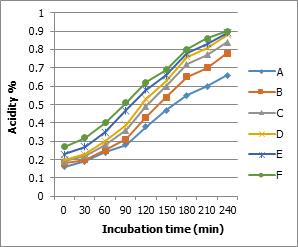
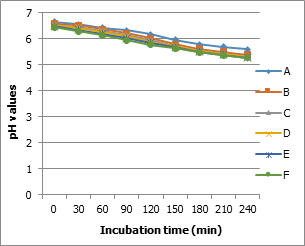
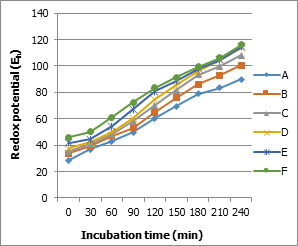
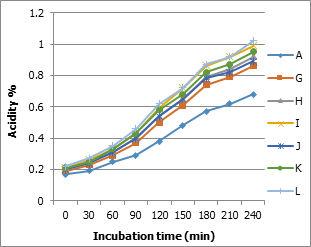
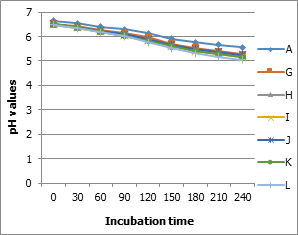
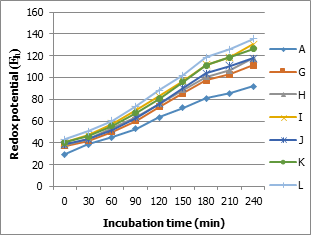
 Scientia Ricerca is licensed and content of this site is available under a Creative Commons Attribution 4.0 International License.
Scientia Ricerca is licensed and content of this site is available under a Creative Commons Attribution 4.0 International License.